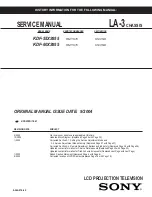
3
LP-3
™
INDICATOR
1. Lubricate bore of body and both sides of the o-ring
diaphragm with silicone lubricant BW-650-M (Bendix
piece no. 291126).
2. Install o-ring diaphragm in body. (Note: o-ring portion of
diaphragm should face supply port.)
3. Install piston in body. Flat side of piston should face
o-ring diaphragm.
4. Install gasket. (Always use a phenolic gasket in a two
terminal switch and a metallic gasket in the single
terminal.)
5. Position contact plate over fingers of piston. Contact
plate should rest on face of gasket.
6. If shim(s) are used, place shim(s) in cover.
7. Place spring in cover.
8. Place contact point so that it rests on spring.
9. Install cover on body, using machine screws, making
certain that the contact plate is in position over fingers
of piston, and arm of contact plate is positioned so that
it will fit in groove of cover.
10. Tighten screws securely. (Torque to 20-30 inch pounds).
TEST OF REBUILT LOW PRESSURE INDICATOR
After rebuilding, perform the leakage and operating tests as
outlined in section “Testing for Serviceability.”
WARNING! PLEASE READ AND FOLLOW
THESE INSTRUCTIONS TO
AVOID
PERSONAL INJURY OR DEATH:
When working on or around a vehicle, the following
general precautions should be observed at all times.
1.
Park the vehicle on a level surface, apply the
parking brakes, and always block the wheels.
Always wear safety glasses.
2.
Stop the engine and remove ignition key when
working under or around the vehicle. When
working in the engine compartment, the engine
should be shut off and the ignition key should be
removed. Where circumstances require that the
engine be in operation, EXTREME CAUTION should
be used to prevent personal injury resulting from
contact with moving, rotating, leaking, heated or
electrically charged components.
3.
Do not attempt to install, remove, disassemble or
assemble a component until you have read and
thoroughly understand the recommended
procedures. Use only the proper tools and observe
all precautions pertaining to use of those tools.
4.
If the work is being performed on the vehicle’s air
brake system, or any auxiliary pressurized air
systems, make certain to drain the air pressure from
all reservoirs before beginning ANY work on the
vehicle. If the vehicle is equipped with an AD-IS
®
air dryer system or a dryer reservoir module, be
sure to drain the purge reservoir.
5.
Following the vehicle manufacturer’s
recommended procedures, deactivate the electrical
system in a manner that safely removes all
electrical power from the vehicle.
6.
Never exceed manufacturer’s recommended
pressures.
7.
Never connect or disconnect a hose or line
containing pressure; it may whip. Never remove a
component or plug unless you are certain all
system pressure has been depleted.
8.
Use only genuine Bendix
®
replacement parts,
components and kits. Replacement hardware,
tubing, hose, fittings, etc. must be of equivalent
size, type and strength as original equipment and
be designed specifically for such applications and
systems.
9.
Components with stripped threads or damaged
parts should be replaced rather than repaired. Do
not attempt repairs requiring machining or welding
unless specifically stated and approved by the
vehicle and component manufacturer.
10. Prior to returning the vehicle to service, make
certain all components and systems are restored
to their proper operating condition.
11. For vehicles with Antilock Traction Control (ATC),
the ATC function must be disabled (ATC indicator
lamp should be ON) prior to performing any vehicle
maintenance where one or more wheels on a drive
axle are lifted off the ground and moving.






















